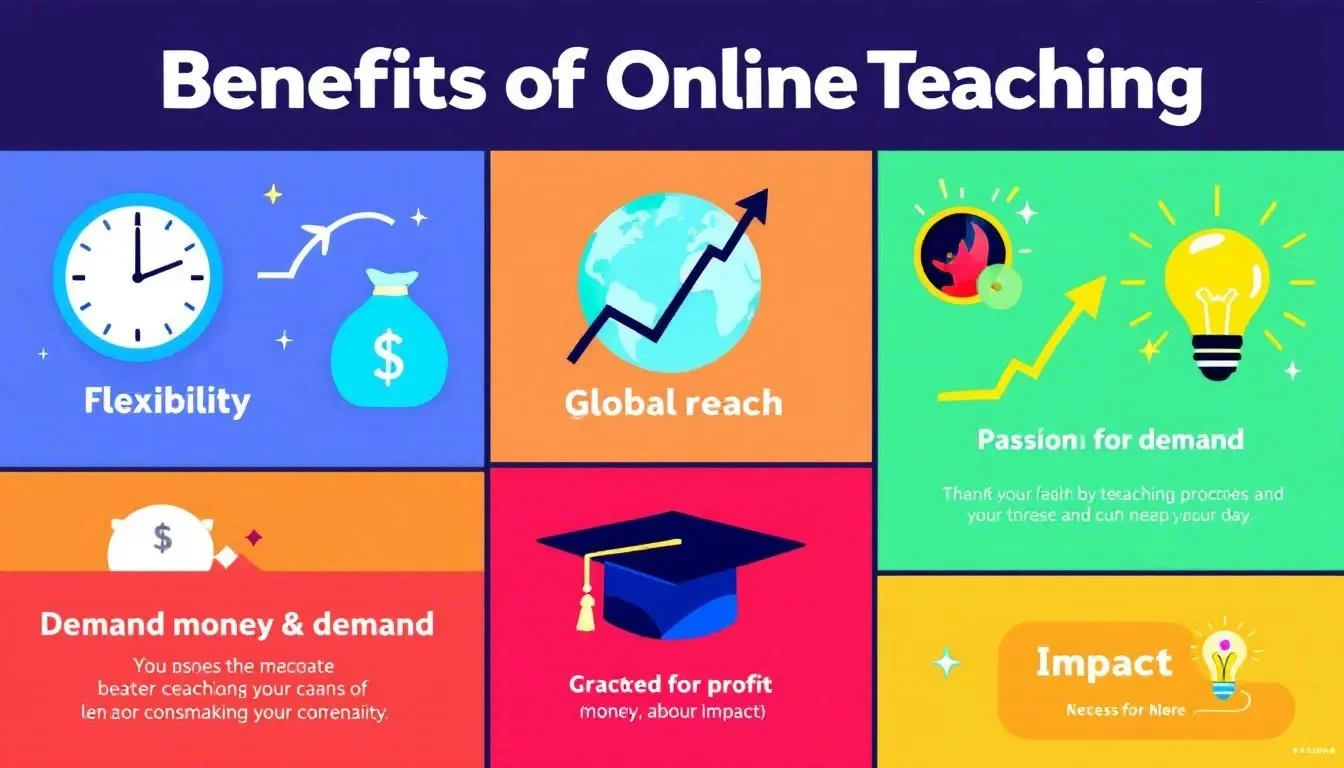Are you a passionate educator, a seasoned subject matter expert, or simply someone driven by the desire to share knowledge and empower others? Teaching or tutoring online has rapidly emerged as one of the most flexible, rewarding, and financially dynamic career paths available today. Whether you're a certified teacher seeking new horizons, a university student with a deep understanding of a particular subject, or a professional looking to monetize your unique skills, the online education landscape is overflowing with untapped opportunities.
This comprehensive guide will illuminate your path to success, walking you through every essential step: from pinpointing your most marketable subjects and selecting the ideal platforms to setting profitable rates, crafting irresistibly engaging lessons, and strategically building a formidable reputation that attracts a steady stream of students. It's time to transform your passion for knowledge into a thriving online enterprise.
Why Teach or Tutor Online? The Unparalleled Advantages

Before we delve into the actionable steps, let's explore why online teaching is such an exceptional opportunity for educators, tutors, and experts alike:
Unmatched Flexibility & Autonomy: You are the master of your own schedule. Teach full-time, part-time, or fit sessions strategically around your existing commitments. You dictate your availability, allowing for genuine work-life balance.
Global Reach & Diverse Learners: Break free from geographical limitations. Online platforms enable you to connect with and teach students across the globe, exposing you to diverse cultures, learning styles, and perspectives. This expands your potential client base exponentially.
High Demand & Growing Market: The shift to remote learning has significantly amplified the need for accessible, high-quality online instruction. Subjects like math, languages (especially English), coding, test preparation, and even specialized hobbies or professional development skills are in soaring demand. The global e-learning market is projected to reach over $1 trillion by 2030, highlighting a sustained growth trajectory.
Scalability & Diverse Income Streams: Your income isn't limited to one-on-one hourly sessions. You can teach larger group classes, pre-record video lessons to sell on demand, or even create and sell digital resources like worksheets, study guides, and e-books, generating passive income online teaching.
Passion Meets Profit: The most fulfilling work often intertwines what you love with how you earn. Online tutoring jobs and teaching roles allow you to share your deepest expertise and passions with eager learners, making a tangible impact while building a sustainable income.
Low Overhead: Compared to traditional brick-and-mortar teaching, online teaching typically has minimal startup costs (a reliable internet connection, a computer, a good microphone/camera, and potentially a platform subscription).
Step 1: Choose the Right Subject(s) & Niche to Teach—Specialize for Success
The foundational step to becoming a successful online teacher or tutor is strategically deciding what you're going to teach. This involves a blend of self-assessment and market analysis.
Assess Your Expertise & Unique Value Proposition:
Knowledge & Passion: What subjects do you genuinely know inside and out? What topics do you get excited about discussing? Passion translates into engaging lessons.
Skills & Experience: What professional skills, certifications, or unique experiences do you possess that others find valuable? (e.g., "I'm a certified Project Management Professional," "I aced the SATs," "I've lived abroad and am fluent in Spanish").
Problem-Solving Ability: What do people consistently ask you for help with? What challenges can you effectively solve for learners?
Examples of Profitable Niches:
Academic Subjects: Advanced Calculus, AP Physics, College Essay Writing, and specific high school history periods.
Languages: Business English for non-native speakers, Conversational Spanish for travelers, and Mandarin for kids.
Professional & Technical Skills: Python for Data Science, UX/UI Design Principles, Digital Marketing Strategy, Resume Optimization, Public Speaking.
Creative Skills: Beginner Guitar Theory, Portrait Photography Editing, Creative Writing for Young Adults.
Test Prep: SAT/ACT Math Strategies, GRE Verbal, IELTS Academic Writing.
Personal Development: Mindfulness for stress reduction, financial literacy for young adults, and effective time management.
Research Demand & Find Your Micro-Niche:
It's not enough to just teach what you enjoy; you also need to gauge the market demand and identify specific sub-niches that aren't saturated.
Google Trends: Use this free tool to see search interest over time for various subjects and niche terms.
Keyword Research Tools (e.g., Ahrefs, SEMrush, or even basic Google searches with "online tutor" + [subject]) to identify what terms people are actively searching for.
Browse Competitor Platforms: Look at popular platforms like Preply, Wyzant, Udemy, and Skillshare. What subjects have many tutors/courses? What subjects are lacking quality instructors?
Forum & Community Analysis: Explore subreddits (e.g., r/learnprogramming, r/languagelearning), Facebook groups, or LinkedIn forums where potential students discuss their learning challenges. What recurring pain points do you notice?
Niche Down Strategically: Instead of offering "English tutoring," consider "IELTS Exam Preparation for Nurses" or "Conversational English for Software Engineers." This helps you stand out, target your marketing, and command higher rates. A narrow niche with high demand and limited quality supply is your goldmine.
Step 2: Select the Right Platform—Your Digital Classroom
Your success as an online teacher significantly depends on where you host your lessons or courses. Different platforms cater to different formats, audiences, and business models.
Live Tutoring Platforms (One-on-One or Small Group):
Ideal for those who enjoy real-time interaction, personalized feedback, and building direct rapport with students.
Pros: Built-in student base, handles scheduling and payments, and often provides virtual classroom tools. Lower marketing effort.
Cons: Platforms take a commission (can be significant), less control over branding/curriculum, and sometimes less flexibility than self-hosting.
Examples:
VIPKid (primarily for teaching English to Chinese children) often requires a bachelor's degree and teaching certification.
Preply connects tutors in hundreds of subjects and languages with students worldwide. You set your own rates and schedule.
Wyzant: Focuses on academic tutoring for U.S.-based students. Tutors set their own rates and manage their profiles.
Italki: Specializes in language exchange and tutoring.
Chegg Tutors: Connects college students and others with tutoring needs.
Online Course Platforms (Pre-Recorded, On-Demand):
Ideal for creating comprehensive courses, reaching a wider audience, and generating passive income. Less real-time commitment.
Pros: Scale your teaching (record once, sell many times), reach a global audience, and the platform handles hosting and payment processing.
Cons: Requires more upfront content creation, marketing is largely your responsibility, and platform fees/commissions.
Examples:
Udemy: Massive marketplace with broad topics. Good for exposure, but high competition and lower payout per sale.
Skillshare: Focuses on creative and professional skills. Income is often based on minutes watched by premium members.
Teachable: Provides tools to create and sell your own courses, with more control over branding and pricing. Good for building a personalized brand.
Thinkific: Similar to Teachable, offering robust course creation and marketing tools.
Coursera, edX: More academic, often requiring university affiliation or strong credentials, but huge reach.
Your Own Website/Self-Hosted Platform (Maximum Control):
Ideal For: Experienced educators looking for maximum control over branding, pricing, student experience, and profit margins. Can combine live tutoring with course sales.
Pros: 100% control, no platform commissions (beyond payment processing), stronger brand building, and ability to offer unique packages.
Cons: Requires more technical setup, significant marketing effort (you're responsible for driving all traffic), and can be more expensive to start.
Tools/Platforms:
WordPress with LMS plugins (e.g., LearnPress, LearnDash): Powerful and flexible, but requires more technical know-how.
Kajabi: All-in-one platform for courses, websites, email marketing, and communities. Higher monthly fee but robust features.
Podia: User-friendly platform for selling courses, digital downloads, and memberships.
Hybrid Model Pro Tip: Many successful online educators use a combination: starting on marketplaces for visibility, then transitioning students to their own platform or offering premium content there.
Step 3: Set Your Rates Strategically—Value Your Expertise
Determining what to charge is crucial. It depends on your subject, experience level, credentials, target audience, and the platform you're using.
Research Market Rates (Be Realistic, Not Cheap):
Don't just pick a number. Look at competitors offering similar services in your niche. What are experienced tutors charging for online tutor rates for SAT prep? What are average course prices for Python for beginners?
Factor in your location (if targeting local students) and the location of your target global audience (e.g., US-based students might pay more).
Common Starting Rates (for live tutoring):
Beginner/General Subject: $25-$40 per hour.
Experienced/Niche Subject/Test Prep: $40-$75+ per hour.
Highly Specialized/Professional Coaching: $80-$200+ per hour.
Course Pricing: Can range from $20 for a mini-course to $500+ for a comprehensive program, often based on perceived value and depth.
Consider Your Value & Expertise:
Specialization: If you're in a high-demand, niche area (e.g., AI coding, advanced statistical analysis), you can charge more.
Credentials: Degrees, certifications (e.g., TESOL, PMP), or professional experience add significant value.
Results: Can you promise specific outcomes? (e.g., "Improve your IELTS score by 1 band," "Learn to build a basic web app in 8 weeks"). Value-based pricing allows you to charge for transformation, not just time.
Pricing Models:
Hourly Rate: Standard for one-on-one tutoring.
Packages: Offer bundles of lessons at a slight discount (e.g., "5-hour Math Tutoring Pack for $200" instead of $45/hour). This encourages larger commitments.
Subscription/Membership: For ongoing access to content, group lessons, or a community.
Tiered Pricing: For courses, offer different tiers (e.g., Basic course access, Premium with 1-on-1 support, VIP with coaching calls).
Payment Processing:
Platforms: Most platforms handle this, taking a commission.
Self-Hosted: You'll need to integrate payment gateways like PayPal, Stripe, or Square.
Quick Tip: Don't undervalue yourself, especially if you're offering tailored, high-quality instruction in a specialized area. Your expertise is a valuable asset. Be confident in your rates and be able to articulate the value you provide.
Step 4: Create Engaging Lessons & a Positive Learning Environment—Beyond the Screen
Teaching online comes with unique challenges but also powerful tools to keep your lessons interesting and effective and to foster a positive learning environment.
Plan Thoughtfully & Personalize:
Structured Curriculum: Even for tutoring, have a clear plan for each session or course module, outlining objectives, activities, and expected outcomes.
Tailor to Learners: Adapt your lessons based on your audience's learning styles, prior knowledge, and specific goals. Some students might prefer practical exercises, others thrive on live discussions, and some benefit from visual aids. Conduct an initial assessment.
Pre- & Post-Lesson Activities: Provide materials for students to review before a session and exercises to reinforce learning afterward.
Incorporate Technology & Interactivity:
Virtual Classroom Tools: Utilize features of platforms like Zoom, Google Meet, or built-in classroom tools.
Screen Sharing: To demonstrate software, websites, or present slides.
Digital Whiteboards: For collaborative problem-solving, brainstorming, and visual explanations (e.g., Miro, Jamboard).
Breakout Rooms: For small group discussions or activities in larger classes.
Polls & Quizzes: For quick knowledge checks and engagement (e.g., Kahoot!, Mentimeter).
External Tools:
Canva: For creating visually appealing presentations, worksheets, and social media graphics.
Loom/Descript: For recording quick video explanations or feedback.
Google Docs/Slides: For collaborative real-time document creation and sharing.
Multimedia Integration: Embed relevant videos, audio clips, or interactive simulations to break up lectures and cater to different learning preferences.
Keep Things Dynamic & Interactive:
Active Participation: Encourage questions, discussions, and hands-on activities. Don't just lecture.
Feedback Loops: Provide timely, constructive feedback. Use annotation tools on shared documents or screens.
Varied Activities: Mix up your teaching methods: mini-lectures, Q&A, group work, individual practice, case studies, and role-playing.
Build Rapport: Engage personally. Ask students about their day, interests, or challenges. A positive relationship fosters better learning. Use the camera and microphone effectively to create presence.
Step 5: Market Your Services & Build Your Reputation Attract a Steady Stream of Students

Once your services are defined, you need to actively market yourself. A strong reputation, fueled by strategic marketing, will attract more students and allow you to increase your rates over time.
Build a Professional Online Presence:
Optimized Profiles: On any platform you choose (Preply, Udemy, your own site), ensure your profile is complete, professional, and highlights your unique selling proposition. Use a clear headshot.
LinkedIn: Optimize your LinkedIn profile to showcase your teaching experience and subject matter expertise. Share insights, engage with relevant groups, and connect with potential students or parents.
Professional Website/Landing Page: Even a simple one can act as your central hub, showcasing your services, testimonials, and contact info.
Content Marketing (Attract Students Organically):
Share Your Expertise: Create valuable, free content that helps your target audience.
Blog Posts: Write articles on common challenges in your subject (e.g., "5 Common Mistakes When Learning Python," "How to Conquer Difficult Math Problems").
YouTube/TikTok Videos: Create short tutorials, quick tips, or problem-solving demos related to your subject. Show your personality and teaching style.
Social Media: Share engaging snippets, Q&As, or mini-lessons on platforms where your audience spends time.
Lead Magnets: Offer a valuable freebie (e.g., a "Beginner's Guide to Conversational Spanish" PDF, a "Sample Coding Exercise with Solution") in exchange for an email address. This builds your email list for future marketing.
Leverage Testimonials & Social Proof:
Ask for Reviews: Actively request testimonials or reviews from satisfied students after a few classes or course completion. Positive word-of-mouth is incredibly powerful.
Display Prominently: Feature these testimonials on your profiles, website, and marketing materials. Use screenshots of positive feedback (with permission).
Case Studies: For more extensive courses or long-term tutoring, create mini-case studies showcasing a student's progress and results.
Engage with Communities:
Online Forums: Participate in relevant online forums, Facebook groups, or Reddit communities where your target students hang out. Offer genuinely helpful advice (without self-promotion).
Networking: Connect with other educators or professionals in your field. Referrals can be a great source of new students.
Consider Paid Advertising (Strategic Growth):
Once you have a proven service and solid testimonials, consider small, targeted ad campaigns on Google, Facebook, or Instagram to reach specific demographics looking for your subject.
Step 6: Scale Up Your Online Teaching Business—Maximize Your Impact & Income
Once you've gained traction and refined your teaching approach, think strategically about ways to expand your reach and maximize your income potential.
Create Pre-Recorded Courses & Digital Products:
Evergreen Content: Transform your popular live lessons into comprehensive, pre-recorded online courses. This allows you to sell your knowledge repeatedly, generating passive income.
Digital Downloads: Offer supplemental materials like e-books, worksheets, templates, practice tests, or flashcards as standalone products.
Mini-Courses/Workshops: Create shorter, focused courses on a specific topic as an upsell or an entry point.
Host Group Lessons & Webinars:
Increased Earnings: Teach multiple students simultaneously. While the per-student rate might be lower, your overall hourly earning potential increases significantly.
Webinars: Host free or paid webinars on popular topics to attract new leads and showcase your expertise.
Develop Tiered Offerings:
Offer different levels of service:
Basic: Self-paced course.
Standard: Course + access to a private community forum + occasional group Q&A sessions.
Premium: Standard + limited 1-on-1 coaching calls.
VIP: Premium + extended 1-on-1 coaching + personalized curriculum design.
Build a Community:
Create a private Facebook group, Discord server, or use a platform's community feature. A strong community fosters engagement, provides peer support, and creates a loyal student base.
Collaborate with Other Educators/Influencers:
Partner with complementary educators for joint webinars, cross-promotion, or co-created courses. This expands your reach to new audiences.
Consider Building a Team (Advanced):
As demand grows, you might hire other tutors to work under your brand, allowing you to manage and scale your online education business even further.
Common Challenges & Strategic Solutions
While rewarding, online teaching does present challenges:
Competition: The market is growing.
Solution: Niche down, build a strong personal brand, focus on testimonials and results, and provide exceptional value.
Student Engagement in a Virtual Setting: Keeping Learners Focused and Motivated Online.
Solution: Implement interactive tools and varied activities, build strong rapport, and provide frequent, personalized feedback.
Technical Issues: Internet connectivity, software glitches.
Solution: Have a backup plan (e.g., phone hot spot), test your equipment before sessions, provide clear instructions for students, and be patient and flexible.
Time Management & Burnout: Balancing lesson creation, teaching, marketing, and administration.
Solution: Set clear boundaries for work hours, automate repetitive tasks (scheduling, invoicing), and repurpose content (e.g., turn a live lesson into a course module).
Client Acquisition: Consistently finding new students.
Solution: Diversify marketing efforts (platforms, social media, content), nurture leads via email, and prioritize referrals.
What's Next? Your Journey to Impact & Income Begins!
Teaching or tutoring online is far more than just an income source—it's a profound way to make meaningful connections, empower curious minds, and build a truly impactful career. Whether you’re just getting started on your path or looking to significantly grow your existing teaching endeavors, diligently applying these strategic steps can position you for unparalleled success.
Don’t wait to start sharing your invaluable expertise with the world. Take that crucial first step: pick your subject, choose a platform, and prepare to make a lasting impact on countless learners while building a fulfilling and profitable online education business.



